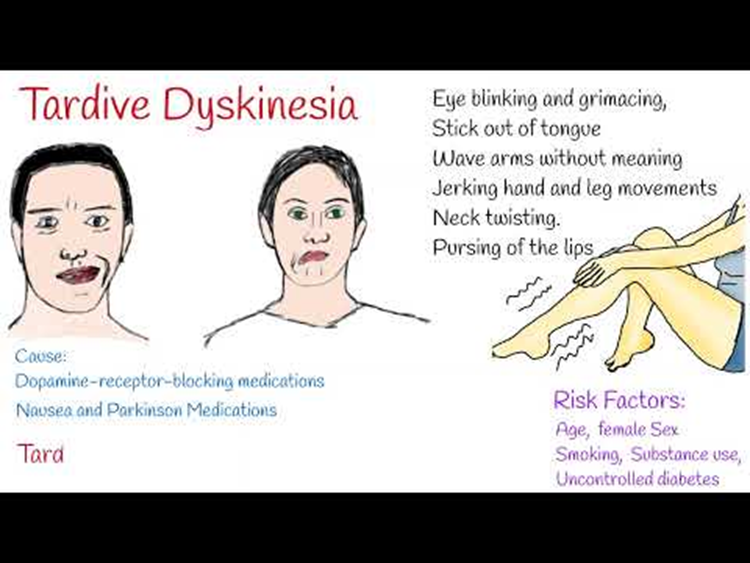Which behavior displayed by a patient receiving a typical antipsychotic medication would be assessed as displaying behaviors characteristic of tardive dyskinesia (TD)?
Falling asleep in the chair and refusing to eat lunch
Grimacing and lip smacking
Having excessive salivation and drooling
Experiencing muscle rigidity and tremors
The Correct Answer is B
A. Incorrect. Falling asleep in the chair and refusing to eat lunch is not indicative of tardive dyskinesia (TD). TD is characterized by involuntary movements, not by changes in sleep patterns or appetite.
B. Correct. Grimacing and lip smacking are characteristic movements associated with tardive dyskinesia. TD is a side effect of long-term use of typical antipsychotic medications, and it involves involuntary, repetitive movements, often involving the face and mouth.
C. Incorrect. Excessive salivation and drooling are not specific to tardive dyskinesia. These symptoms may occur due to various reasons, and TD is primarily associated with abnormal, involuntary movements.
D. Incorrect. Experiencing muscle rigidity and tremors is more characteristic of other side effects or conditions, such as extrapyramidal symptoms, but it is not specific to tardive dyskinesia. TD typically involves repetitive, involuntary movements rather than tremors.

Nursing Test Bank
Naxlex Comprehensive Predictor Exams
Related Questions
Correct Answer is B
Explanation
A. Axons: Axons are nerve cell processes that transmit signals away from the cell body. While axons are essential for communication between nerve cells, their structure or function is not directly implicated in the altered behavior associated with schizophrenia.
B. Neurotransmitters: This is the correct answer. In schizophrenia, there is evidence of dysregulation in neurotransmitter systems, particularly dopamine. Dopamine dysregulation is associated with both positive and negative symptoms of schizophrenia. In the case of negative symptoms, such as social withdrawal and reduced emotional expression, hypoactivity in dopamine pathways may play a role.
C. Dendrites: Dendrites are nerve cell processes that receive signals from other neurons. Similar to axons, dendrites are crucial for communication between nerve cells, but their structure or function is not specifically implicated in the altered behavior associated with schizophrenia.
D. Synapses: Synapses are the junctions between nerve cells where neurotransmitters are released to transmit signals. While synapses play a critical role in neurotransmission, the altered behavior in schizophrenia is more closely linked to the dysregulation of neurotransmitters, particularly dopamine, than to structural changes in synapses.
Correct Answer is D
Explanation
A. Enables the nurse to assign the appropriate Axis I diagnosis: Nurses typically do not assign Axis I diagnoses. Diagnosing mental health conditions is typically the responsibility of psychiatrists, psychologists, or other licensed mental health professionals. Nurses, however, play a crucial role in gathering information to contribute to the overall assessment process.
B. Enables the nurse to prescribe the appropriate medications: Nurses do not prescribe medications; that is the responsibility of physicians, nurse practitioners, or other prescribers. However, gathering client information is essential for providing accurate information to the prescriber, assisting in medication management, and monitoring for side effects.
C. Enables the nurse to modify behaviors related to personality disorders: While nurses can assist in the management of behaviors related to mental health conditions, the primary purpose of gathering client information is not to modify behaviors related to personality disorders. It is more about understanding the client's needs and tailoring care accordingly.
D. Enables the nurse to make sound clinical judgments and plan appropriate care: This is the correct answer. Gathering client information is a fundamental step in the nursing assessment process. It provides the necessary data for the nurse to make informed clinical judgments, identify health problems, and plan appropriate care interventions. It allows the nurse to understand the client's unique needs, preferences, and potential risks, leading to individualized and effective care planning.
Whether you are a student looking to ace your exams or a practicing nurse seeking to enhance your expertise , our nursing education contents will empower you with the confidence and competence to make a difference in the lives of patients and become a respected leader in the healthcare field.
Visit Naxlex, invest in your future and unlock endless possibilities with our unparalleled nursing education contents today
Report Wrong Answer on the Current Question
Do you disagree with the answer? If yes, what is your expected answer? Explain.
Kindly be descriptive with the issue you are facing.
